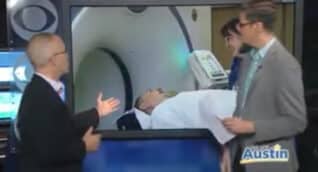A gastric emptying scan measures how fast food empties from your stomach to the small intestine. This procedure helps evaluate abnormal stomach function, which may be caused by stomach ulcers, cancers, medications, and nerve damage from diabetes. In this study, the patient eats a meal into which a small amount of radiopharmaceutical has been added. A specialized scanner is then used to record the time it takes for the meal to pass from the stomach into the intestine. An assessment is then made as to whether the time is normal, too fast, or too slow.
Doctors request gastric emptying scans to evaluate symptoms caused by the stomach emptying too quickly or too slowly. This includes symptoms of diarrhea, ligheadedness, weakness, or early satiety when the stomach empties too quickly. It includes symptoms of nausea, vomiting, abdominal pain and persistent fullness after eating when the stomach empties too slowly.
Slow gastric emptying may be due to gastric outlet obstruction which is when something blocks the area where the stomach connects to the small intestine. Gastric outlet obstruction may be caused by:
- Built up scar tissue from peptic ulcers
- Cancers of the stomach, pancreas or duodenum (first section of the small intestine)
Delayed gastric emptying may also be due to gastroparesis, a condition that results from the dysfunction of stomach nerves and muscles. Gastroparesis may be caused by medications, diabetes or other illness.
- The exam takes approximately 4 hours, but most of the time is spent relaxing while you digest the meal.
- You will be given a small meal to which a small amount of radiopharmaceutical has been added, and water. The standard meal consists of eggs or egg white substitutes, 2 slices of bread or an equivalent amount of crackers, jam, and water. Those who are allergic to eggs can have a mac-and-cheese meal. Other substitutions are also possible. Please contact the ARA staff in advance at the center where you will be having your exam to inform them of any dietary restrictions you have.
- A specialized scanner will take pictures of your abdomen at different times to follow your digestion. The pictures are taken at 1 hour, 2 hours, 3 hours, and 4 hours after the test meal. It takes about 5 minutes to obtain each image.
- You may leave the exam room between the times when images are taken. Do not eat or exercise until all the images have been taken and be sure to be ready at the exact times given for the imaging.
- After the procedure, you can return to your normal activities. The radiopharmaceutical is eliminated in your stool, and will pass over the next day or so.
- You cannot eat or drink anything for 6 hours prior to the gastric emptying study.
- Some drugs can affect gastric emptying and should be avoided for 2-3 days prior to the exam. Ask your doctor if you should discontinue these or any other drugs before you schedule your exam. Drugs that may interfere with test results include:
Bentyl
codeine
demerol
domperidone (Motilium)
Donnatal
erythromycin
Fentanyl patch
Hyosyne
Levsin
marijuana
Methadone
metoclopramide (Reglan)
morphine
Oxycontin
Percodan
Percocet (Oxycodone)
Robinul
tegaserod (Zelnorm)
Tylenol #3
Tylox
Ultram (Tramadol)
Vicodin (Hydrocodone) - If you have diabetes, it’s important to have optimal blood sugar control. You will need to check your blood glucose level during the course of the exam and bring any diabetes medication and/or insulin with you as you may need to take your medication during the exam. Ask your doctor about any medication adjustment prior to scheduling the procedure.
- Be sure to tell the technologist about any illness or allergies you may have. Also, provide a list of your current medications.
- Tell the technologist if you might be pregnant or are breastfeeding. There may be an alternate exam to avoid any risk to the developing baby.
To schedule a gastric emptying scan, please call our scheduling team at (512) 453-6100 or toll free at (800) 998-8214. A provider referral is required to make an appointment.
A radiologist who is trained to interpret molecular radiology examinations will analyze the images and send a report to the provider who referred you to ARA. The provider will then share the results with you.

 Back to Top
Back to Top